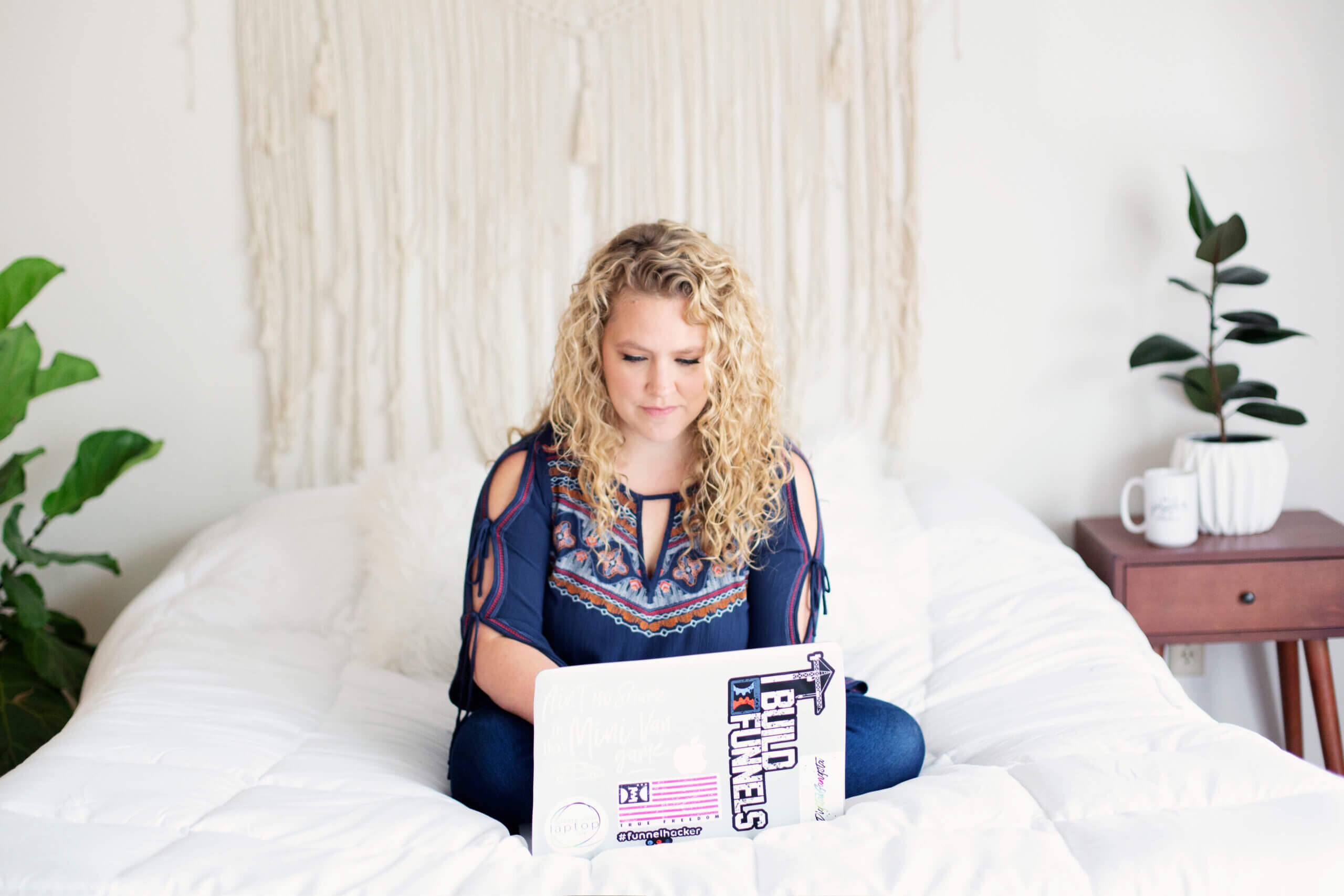Anyone trying to teach the art of a productive life, must include the study of worry as well.
A simple working definition of the word worry is to dwell on unpleasant thoughts, feelings, difficulties, or potential trouble. Humans worry about things that have already happened or might happen in the future, whereas anxiety is usually what you feel in your body when you’re worrying about something that is presently happening.
The #1 killer of productivity is worry. It paralyzes your critical thinking skills, floods the brain with warning signals, and like a magnet, attracts every random and possible additional worrisome thought within 100 miles.
If you’re trying to sleep, write, compose, study, or any other activity that requires concentration and some level of brain space, worry loves to rush in and attempt to steal the show.
So how do we stop the cycle of worry that leads to procrastination, self-sabotage, and medicating with distractions like Netflix and food?
It might seem counter intuitive, but it works.
We’re going to pick a time in our day to purposely worry.
The Worry Dump
The next time you feel that rising sense of dread, instead of trying to bat away the thoughts like flies, we’re going to give them a moment of respect and attention.
It’s important that you do this exercise completely (not missing any steps). You don’t give worry total control of your mind, heart, and time, but with careful boundaries, actually ALLOWING yourself to worry becomes the mechanism by which the thoughts pass through you instead of getting stuck inside you.
It starts with a little notebook and pen.
Step One: Sit down in a quiet place.
Step Two: Start free writing whatever comes into your head. If you can’t seem to start, just write this phrase…
“I’m worried I won’t be able to do this worry dump right.” LOL
Then observe the very next thought that hits you… is it, “That’s dumb. Who doesn’t know how to worry?” or maybe it’s, “I’m so worried that my worries will come flooding out and never end.” Whatever it is, don’t judge it. Just write it.
Step Three: Keep writing one line per worry.
“I’m worried that….”
“I’m worried that….”
and on…
Keep going until you feel a natural lull. Then push yourself back to the notebook and keep looking inside your mind. Are there any other worries hiding out in corners?
Step Four: Flush out every possible negative thought swirling in your brain. Get it out on the notebook. Lean in and push yourself to worry just a bit more.
This may take you five minutes or an hour. It depends on how much you’ve avoided or used denial to cover up worrisome thoughts. Once you feel that you’ve exhausted your worries, put your pen down and close your eyes.
Step Five: Take a few deep cleansing breaths. It’s possible you might be on the verge of tears, and that’s okay. You can cry and breathe at the same time.
At this point, one of two things will happen. For some of you who aren’t prone to worrying, that exercise might actually be enough to create the calm you need to get back into the creative mode.
For others of you that are professional worriers, you’ll need to continue onto the next few steps.
Step Six: Evaluate your worries. Run through the list and mark each one the following way:
- For worries that are internal (i.e. I’m worried I’m fat), logically write down next to it the percentage of truth the statement actually has (100% if it’s so true that 100 people would say, yeah that’s right, all the way down to 0% – not one of the 100 people would agree with you)
- For worries that are external (i.e I’m worried that my house might catch on fire), logically write down next to it the percentage of possibility that statement actually has (100% chance my house will burn down, down to 0% chance my house will burn down).
For thoughts that are too complex to categorize simply (i.e I’m worried that my business won’t make the money it needs to in order to send my kids to college), you’ll need to deconstruct them a bit more. That worry is really multi layered and could mean any (or all) of the following:
- I’m worried my business won’t make enough money
- I’m worried my kids won’t get the chance to go to school
- I’m worried I’ll feel so much pain if they miss out on this life opportunity
- I’m worried I’m a bad mom for not being able to pay for their school
- I’m worried my kids will live at home forever because they can’t get a good job
Cross out the ones that aren’t true, and then assign percentages to the ones that are true.
Step Seven: Segregate your worries.
You’re going to have a lot of them that are less than 50% chance of happening. Like a TON. In fact, and this is sort of left to interpretation, but pick a percentage you’re comfortable betting on. Is it 50%? 30%? If I look at the weather and it says 20% chance of rain, I’m reasonably confident it won’t rain. So I would choose 20%.
I would put all the worries that are OVER 20% in one pile and all the ones less than 20% in another.
Step Eight: Logically “worst case scenario out” the ones that are over your threshold.
Since I am looking at anything over 20%, chances are I’ll have a few in my bucket to logically deconstruct. Someone whose threshold is 60% might realize there’s nothing to actively worry about! You can end the exercise here if your brain feels calm enough to get back to productivity. But the idea is to go through the worst case scenario of every high threshold worry and rationalize how you would survive that situation.
Let’s look at something like…
“I’m worried I’ll feel so much pain if my kids miss out on going to college”. That worry was 100% true. I would in fact feel pain if they missed out on something. But logically, isn’t it normal to feel pain when someone we love is hurting? Sure! That’s not weird. That’s life. And then I can logically reason that there have been other times in my life I’ve felt pain on their behalf, and I survived each one. It wasn’t a matter of life and death. It was just uncomfortable. And I can go even as far as to say that I will have to face this pain multiple times in their life, whether it is my fault or not. And…many other moms and dads feel this way. I’m not alone. Then I might look at how them missing an opportunity actually opened a door to another one that made them really resilient!
By the time I’m done logically deconstructing this, the worry has INFINITELY less power.
Let’s try another one.
“I’m worried my business won’t make enough money.” I randomly categorized this one at 50% chance. One in every two businesses fail, so I figured those are the odds for me too. So it’s well over the 20% threshold so I have to go at it with worst case scenario thinking. Let’s say it doesn’t make enough money. What would I do next? I’d go find another job or business and try again. I might get into debt while I’m trying to get back on my feet. If my debt got high enough, I might even have to file for bankruptcy and live with my parents. I’d live at home and eventually my parents would pass on and maybe I would inherit their house. I might eventually find a job and get back on my feet. In no way do I end up homeless or dead.
Go through every worry in that high threshold pile and just hammer it out with logic.
Step Nine: Glance at your other pile of worries (the less likely ones).
After all that brain work, chances are the worries with 1%, 2%, 5% chances are so low, they won’t even seem so scary or hard anymore. It’s impossible for our brain to really watch every danger in life after all. Think about it. I’m sitting here writing this post (worrying it’s not good enough), but I’m not worried the plane is going to crash. Even though the woman next to me might be scared of crashing, no one can be worried about everything all the time. Which means, there are ways we are rationalizing other dangers away to keep the worries at bay.
Ever thought about how one person can be TERRIFIED to drive without a seatbelt on and the other person doesn’t even think about it? If the brain can’t worry about everything, then it’s clearly using a complex process to prioritize worries in order to keep the brain from shutting down in panic.
This exercise gets your worries out on paper, gives you a quick way to rate them in priority, and work through the worst case scenario to get to the other side.
Since you’ve done it with the “more likely” thoughts, it makes all the tiny less likely worries seem minuscule and unimportant, and your brain is able to push them down the list of priority.
Step Ten: Time to close your notebook and get back to whatever it is you were doing. You should feel a TON better. If a worry creeps in while you’re working, just jot it down in your notebook so you can focus on “worrying” about it later. That way the brain will feel reassured that you haven’t forgotten the danger, you’re just pushing it aside for the moment.
Some people need to do this everyday. Others only when it’s a really stressful season of life. Just remember this: Avoidance and denial often make our brain MORE persistent in reminding us of the danger. Give it just enough attention to destroy the worry with logic, and you’ll find yourself taking control of your thoughts in a new way.









Good stuff, Julie. And congratulations on the progress you have made.
May I add a one-liner from Dale Carnegie’s ‘other book’, How to Stop Worrying and Start Living…
“Live life in day tight compartments” – or we might say today, “One day at a time.”
It’s not going to help everybody in all situations. I can only say it was a breakthrough thought for me many years ago.
What I like about this exercise, even if one were to completely avoid the real work and just visualize it, is it gives the worry space – but just enough to shine light and truth onto it.
We so over emphasis what has little to no hold on us, or offers no way for us to control it, so the worry is just an energy and creativity leak.
I have a degree in worry. LOL. I fight it everyday. I’ve accepted it is part of my DNA and so I practice everyday calling it out and naming it the garbage it is, the red flag it is, or even the help it may be.
I see my worries like a room full of people at a house party. Everyone introduces themselves but it takes a little query to prove how they present themselves as right or wrong. Some you know to avoid right away, some you consider more thoroughly. I treat worries like that. I try to make them their own thing if that makes sense.
Julie, you wrote a GREAT post. Lots of time and thought into it and lots of help offered. Thank you!
Thank you for this!
Hi Julie,
Thanks so much for this exercise! I used to think I didn’t worry about anything, I just got panic attacks for no reason. Then I realized I was in denial. I have some complex and deep worries. They will take some deconstruction, but I will try this technique. The worrying causes procrastination that can insure all my worries to come true. So thank you!
Julie Hodges
I appreciate this post for so many reasons. I am finding that I hide my worry quite well from most people, though not my husband. He unfortunately sees my worry firsthand. I love that I am able to share this post too. Thank you for being vulnerable and sharing these great tips that can help others. Speaking of worry, I just saw this video last week and found it to be profound regarding anxiety. Tv.jw.org > Video On Demand > From Our Studio > May 2019 Monthly Program about worry and anxiety. It was phenomenal. I’m implementing a few suggestions from that video also.
Love this! I am a big believer in listening to what is happening inside of us rather than trying to stifle those inner voices, even when the voices are saying things we don’t want to hear. It had not occurred to me to give attention to my many, many worries. I am kinda feeling “like, DUH!” Thanks so much, I cannot wait to try your approach!
Thank you for this. My husband has extreme anxiety and worries.
Wow. This is really helpful! I especially struggle with worry first thing in the morning when I wake up and am just lying in bed for a few minutes before starting my day. As I go down the well beaten worry path my stomach begins to churn with anxiety. Once I get out of bed most of the anxiety drops away as I get busy with work but the stomach symptoms take a little longer to subside. Then I worry that if I don’t stop worrying I’ll become physically ill as a result of stress and worry… Ugh.
Thanks for this article. Am definitely going to try it out.
This was an incredible post!